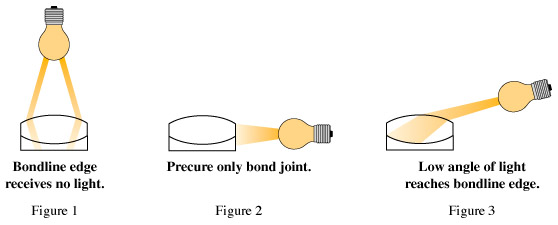Preventing Lens Separations
with
Norland Optical Adhesives
Lens separations or bond failures can be divided into two types, adhesive and
cohesive. Identifying which of these two types of failure is occurring will
determine what steps to take to prevent them.
1. Adhesive failure
occurs when the cement separates from the glass surface. It is
seen as a shiny area in reflected light. It can be any shape and
can be identified by the presence of Newton rings, or a color
fringe.
2. Cohesive failure
occurs when the cement pulls away from itself. This can be identified
by the fern-like voids, called feathering, appearing along the
edge of the lens or sometimes in the interior.
When adhesive failure is identified:
Because Norland Optical Adhesive
has excellent adhesion to glass, adhesive failure is not a serious
problem. When this type of failure does occur it is usually caused
by a lack of cleanliness of the glass surfaces. If there is a
trace of oil, fingerprints, dirt or any contamination between
the cement and the glass there is a potential for adhesive failure.
The solution for this is to look closely at the cleaning process.
Things like contaminated solvents or improper handling could be
the cause.
When cohesive failure is identified:
Cohesive failure is due to internal stress
in the cement and is caused by uneven curing. By uneven curing we mean there
is a great change in UV light intensity from one portion of the cement to the
next causing one portion to cure slower than the rest. Simple causes of uneven
curing are shadows cast by such things as the ground edge of the lens or a part
of a jig or clamp used to align the lens.
The danger of curing unevenly
is greatest during the precure. This is when the cement changes
from a liquid to a solid and shrinkage occurs. Normally this slight
amount of shrinkage will not form stress but will pull the two
glass surfaces closer together.
After the lens is precured
the two glass surfaces cannot move. Any cement in a shadow will
not have been precured yet and when it does cure it cannot pull
the surfaces closer together. This area now has internal stress
which will eventually lead to cohesive failure.
Simple causes of cohesive failure
can be corrected by eliminating any shadows from the bondline.
Ways to do this include changing the position of the light source,
adding more lights or clamping the lens in a different way.
A less obvious cause for uneven
curing is due to the configuration of some lenses. Certain lenses
will send the light entering towards the center of the lens so
that it doesn't reach the edge. These lenses can be identified
by the fact that the bondline edge is not visible to the eye when
observed through the top lens. See Fig. 1. Because the edge is
not cured at the same time as the rest of the lens it will have
internal stress which will lead to cohesive failure.
There are a number of ways to overcome this.
An even cure can be had if the lens is exposed to UV light through the bottom
lens. If it is not possible to invert the lens for the precure, the light can
be placed at the same height as the edge of the lens and only cure the bond
joint during the precure. Fig. 2. This is done as the lens is rotated during
alignment. The lens is then inverted and the whole optical bondline is given
an even cure. Another method for precuring is to have the light at a very low
angle to the top lens surface. The low angle of light is able to reach the edges
in many cases. Fig. 3.
In summary, Norland Optical
Adhesives will do an excellent job of bonding precision optical
components when properly handled. If separations do occur, first
identify if it is adhesive or cohesive failure and then take the
appropriate steps to correct them.
Bondline edge receives no light.
Precure only bond joint. Low angle of light reaches bondline edge.

Click HERE to go to a Power Point Presentation that gives you additional
information.
Home
-
Adhesives -
Fiber Optics -
Fish Gel -
Distributors -
About -
Trade Shows -
Employment
| 








